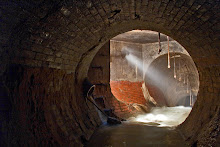The passage that I have chosen is on page 151 of the Picador edition. 'The articles and illustrations he found in the Riverdale Library depicted every detail about the soil, the wood, the weight of the concrete, everything but the information of those who actually built the bridge..... Official histories, news stories surround us daily, but the events of art reach us too late, travel languorously like messages in a bottle'.
This passage brought to mind his interview in the course pack, where he writes how he is drawn to the uwritten stories or the 'un-historical' stories. He goes on to say how 'the media have created a false surface of content in which they loll around, and they have to be reminded of the other side'. Through this we can see how the less powerfull voice is being misrepresented or even ignored completely. We can see in the passage how information of the people who built the bridge is neglected for simply the empirical data about the bridge. Similarly, Harris knows in detail all the information about the bridge but is distanced from the people who actually built the bridge. This distance between the workers and the people in higher positions can be seen in the simile of 'the politician making a speech after a bridge is built, a man who does not even cut the grass of his own lawn' (151). This is highlighted throughout the novel through comparisons such as the clothes that the commissioner wears and the dirty clothes that the builders wear and for example on page 61 where Ondaatje writes that 'Small's blatant capitalism had clarified the gulf between the rich and the starving'.
The passage continues to devalue the mere facts of history with comparing them with the photographs of Lewis Hine, 'who in the United States was photographing child labour everywhere...' and how Hine's photographs betray official history and put together another family'. These photographs provide an insight into the actual conditions that are often ignored and covered up by the 'official history'. However, even though these photographs do show images of these things that are usually ingnored such as the deaths that occured during the building of the bridge, there is also a bitter tone to it as we are told that Patrick would never see this work and that 'the events of art reach us too late'.
Putting Together Another Family is one of the articles in the course pack for this week. It quotes Linda Hutcheon who writes that "[Canada's] history is one of defiing itself against its centre" but as the article then goes on to say, if we seen Canada as the ex-centric, what about the ex-centrics within Canada? 'In the Skin of A Lion' moves away from the ideas of national identity to other 'repressed histories'.
Subscribe to:
Post Comments (Atom)

1 comment:
The question of what kind of information gives us a true representation is a problematic one: an engineer would probably find the kind of detail Ondaatje gives us to be next to useless, but as literary analysts we would no doubt find detail about materials and height and degrees of elevation etc to be just as pointless. Perhaps it comes down to which body of knowledge (which discourse, if you will) gets to be master, gets to trump all the others. If what the newspapers and the archives usually give us is empirical detail and details about official dignitaries, then Ondaatje can be seen as trying to redress the balance.
This project of seeking the ex-centrics within the ex-centric that you allude to in your last paragraph can sometimes be seen as a pointless one (or caricatured as ‘politically correct’). It strikes me, though, that you could see it as a particularly productive for novelists, who are after all in the business of telling stories, as it has the potential to generate multiple narratives.
Post a Comment